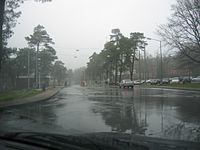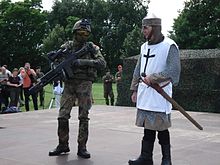Field Marshal Rommel Barracks (Augustdorf)
|
|
|||
|---|---|---|---|

North gate of the barracks (exit) |
|||
| country | Germany | ||
| local community | Augustdorf | ||
| Coordinates : | 51 ° 55 ' N , 8 ° 46' E | ||
| Opened | 1937 | ||
| Workforce | 4,300 | ||
| Stationed troops | |||
|
Panzerbrigade 21 and others |
armed forces | ||
| Old barracks names | |||
| 1937-1945 1945-1950 1956-1961 |
North camp Hutted Camp New camp |
|
|
| Formerly stationed units | |||
| Panzer Battalions 211, 213, 214 Panzer Reconnaissance Battalion 7 Panzer Artillery Battalion 215 and others |
|
||
|
Location of the Generalfeldmarschall-Rommel-Kaserne in North Rhine-Westphalia |
|||
The Generalfeldmarschall-Rommel-Kaserne (short: GFM-Rommel-Kaserne ) is a large barracks of the Bundeswehr in Augustdorf , North Rhine-Westphalia . The barracks are primarily the location of Panzer Brigade 21 “ Lipperland ”. The barracks was laid out in 1937 as a north camp for the nearby Landwehr exercise area and named after Field Marshal Erwin Rommel in 1961 .
location
The barracks are located in the middle of the Senne in the northeast of the Lippe municipality of Augustdorf and on the southern edge of the Teutoburg Forest . Northwest of the barracks is the training area stack , to the south adjoins a location shooting and is under British administration training area Senne on. In front of the north gate are two garrison churches, including the church " Maria, Königin des Friedens ", and the soldiers' home "OASE - Haus Senne", which was reopened on July 3, 2019 after renovation. The path along the barracks fence ("barracks round") has a length of 5.2 km. The barracks represent a significant economic factor for the small community of Augustdorf, which is strongly influenced by the Bundeswehr .
Stationing and facilities
According to the number of soldiers stationed there, the barracks are the largest barracks in the German army , but not their largest location. The number of permanent posts is around 4,300.
The following Bundeswehr agencies are stationed:
-
 Panzerbrigade 21 "Lipperland" (nickname from June 1988)
Panzerbrigade 21 "Lipperland" (nickname from June 1988)
- Staff Armored Brigade 21
- Headquarters and Telecommunication Company Panzerbrigade 21
-
 Panzerbataillon 203 (PzBtl 203)
Panzerbataillon 203 (PzBtl 203)
- 1.–4./Panzerbataillon 203
- 6./Panzerbataillon 203 (not active)
- Combat simulator armored train Leopard 2 (203)
- Shooting simulator Panzertruppe Leopard 2 (203)
-
 Panzergrenadierbataillon 212 (PzGrenBtl 212)
Panzergrenadierbataillon 212 (PzGrenBtl 212)
- 1st - 4th Panzer Grenadier Battalion 212
- Combat simulator Panzergrenadierzug (212)
- Training Support Company 212
- 2nd / Supply Battalion 7
-
 Medical support center Augustdorf
Medical support center Augustdorf - First aid team deployed in Augustdorf
-
5th / Feldjägerregiment 2
-
 Motor vehicle training center (KfAusbZentr) Augustdorf
Motor vehicle training center (KfAusbZentr) Augustdorf - Bundeswehr Service Center Augustdorf (formerly site administration)
- Evangelical Military Parish Office (EMilPfA) Augustdorf
- Catholic Military Parish Office (KMilPfA) Augustdorf
- Family Care Center (FBZ) Augustdorf
- BWI Informationstechnik GmbH SC Hanover VOS Augustdorf
- Voluntary reservist work Augustdorf
- Army repair logistics (HIL) base Augustdorf
- Youth officer Augustdorf
- LH Bundeswehr Bekleidungsgesellschaft mbH service station Augustdorf
- Sports teacher (SportLhr) Augustdorf
- Air Force Liaison Command to Panzer Brigade 21 (VKdoLw PzBrig 21)
- Support staff for site elder (UstgPers StOÄ) Augustdorf
- Support staff for the barracks commander (UstgPers KasKdt) Augustdorf
The brigade staff and the joint home society (GHG, formerly the officers' mess ) are located in the east of the barracks. An element of the Berlin Wall is set up in front of the staff building . Other facilities include the combat and shooting simulator center, a driving safety training course for the German Traffic Guard , three sports fields with running tracks, several sports halls, a swimming pool with sauna, a leisure center, a troop kitchen, an obstacle course and four tennis courts. The "Paradestraße" runs through the barracks from the main entrance north gate to the south gate. The central roll call area is Scharnhorstplatz .
Former units
The military history collection Lippische Rose on approx. 1400 m² reminds of various units that have since been disbanded and that had their home in Augustdorf, e. B. the tank battalions 211, 213 and 214, the tank reconnaissance battalion 7 and the independent brigade units such. B. Panzerjägerkompanie 210. The traditional room of the former 7th Panzer Division is also located here. In addition, the MGS Lippische Rose collects vehicles, weapons and other material from the history of the Bundeswehr and, to a lesser extent, the National People's Army . Dozens of regular but now controlled and test samples of armored tracked vehicles are on display in the barracks.
Other former agencies are the Armored Artillery Battalion 215 and MAD Unit 32.
history

Military units had been practicing in the Senne since 1892 . When the Wehrmacht was enlarged after the National Socialist seizure of power and new locations were needed, a Landwehr exercise area was created in Augustdorf , where the VI. Army Corps from Munster brought his Landwehr battalions to practice in the Senne. The camp was expanded further until 1939 and in 1939 it was handed over to the command office of the military training area. From 1939 the name of the camp was the north camp of the Senne military training area . During the Second World War , a military training camp for the Hitler Youth was added to the northeast . The focus there was on paramilitary military training for young people. In September 1944 an SS training and deployment regiment moved to the north camp. The capacity of the camp was constantly expanding and at the end of the Second World War was 16,000 men. Among other things, the barracks housed the SS Panzer Replacement and Training Battalion 1 of the Waffen-SS , from which the Westphalia SS Panzer Brigade was set up in the last months of the war , which took part in the last tank battle against the 3rd US Panzer Division in March / April 1945 in the Paderborn area . The remaining units in Augustdorf and on the military training area were combined to form Kampfgruppe Augustdorf towards the end of the war and used to defend the transition in the Teutoburg Forest - the Dörenschlucht near Augustdorf. In the "Battle of the Dörenschlucht " from April 2 to 4, 1945, 35 men from a convalescent company of the Waffen SS were killed. They temporarily delayed the advance of the 3rd US Armored Division by shooting down seven Sherman tanks, but were ultimately unsuccessful. The soldiers were buried in a small military cemetery near the barracks. On April 4, 1945 the barracks was occupied by American troops and soon afterwards it was handed over to the British Army , which has remained the main user of the training area to this day.
From 1945 the northern camp, known by the British as the Hutted Camp , was used as accommodation for around 10,000 mainly Soviet prisoners of war , who were returned to their homeland after the end of the war. From the summer of 1945, Eastern Europeans remained in the camp who did not want to return to their homeland; from 1947 these were mainly former prisoners of war from the Baltic Soviet republics. From August 1950 the British released the camp into German administration. Furthermore, about 2,250 homeless foreigners lived in the camp, among them about 600 children. From August 1950, the camp was called the Social Office for Foreigners, Augustdorf Branch .
From February 1956 the old barracks were torn down and rebuilt. After it was rebuilt, the barracks was called the New Camp . According to the plans of the Blank office , the barracks should be the location of the tank reconnaissance school . The current staff building of Panzer Brigade 21 was intended as the teaching office building . The establishment of a military school was of course not implemented. In April 1957, the site administration began its work in Augustdorf. The first soldiers of the Bundeswehr moved to the newly built accommodation in the New Camp on June 26, 1957 . One of the first units was the tank battalion 1 (later first tank battalion 213 , then tank battalion 214 ), which was initially set up in Dedelstorf . The 7th Panzer Reconnaissance Battalion moved from Bremen to Augustdorf in April 1958 . In September 1958 the first foreigners left the camp. On July 20, 1961, the anniversary of the Hitler assassination attempt by the military resistance , the troop accommodation was named Generalfeldmarschall-Rommel-Kaserne . The widow and Rommel's son took part in this act.
The naming of the barracks after Rommel repeatedly leads to criticism due to its ambivalent role in National Socialism.
In May 2018, a spokesman for the Ministry of Defense announced that Erwin Rommel will continue to create tradition for the Bundeswehr even after the new traditional decree. Despite his role in National Socialism, Rommel disregarded criminal orders and was close to the military resistance against Hitler. Therefore "it fulfills the requirements for naming properties of the Bundeswehr."
On April 26, 2007, a solemn pledge for 1,000 recruits from all branches of the armed forces was carried out in the barracks to commemorate 50 years of conscription . In addition to around 3000 guests and relatives, the then Federal Defense Minister Franz Josef Jung and the then General Inspector of the Bundeswehr , General Wolfgang Schneiderhan, were present .
Augustdorf Soldiers Day
Around every two years, Panzerbrigade 21 organizes the Augustdorfer Soldatentag (AST) in the barracks. After 2004, the AST had to be postponed from 2006 to 2007 because the brigade had too many different tasks and missions to deal with in 2006. Several 10,000 guests regularly attend the event. In 2007 (25,000–30,000) and 2009 (30,000–35,000 visitors) the AST was the largest public relations project of the German Army. A soldiers' day took place in Augustdorf on May 9, 2015. It has been part of the Bundeswehr Day since June 10, 2017 .
Shown are the weapon systems of the location in the static and dynamic performances of the arms and looking Panzergrenadiere , Panzertruppe , tanks artillery , logistics , Feldjäger , military reconnaissance troops and sanitary engineering over its special abilities. Reservist fellowships, model making and re-enactment can be found in the military history collection "Lippische Rose" as well as a military-historical fashion show. The Bundeswehr Service Center Augustdorf, the BwFuhrparkService , the fire brigade and the technical aid organization are also represented.
literature
- Dirk Fischer: Panzer Brigade 21 “Lipperland”: Chronicle 1959–2015 . 3. Edition. Self-published, Augustdorf 2015 (brochure without ISBN).
- Location elder Augustendorf (ed.): Location Augustendorf. In the heart of the Lipperland . Mering, 2000 (brochure without ISBN).
Web links
- Panzerbrigade 21 "Lipperland" in Augustdorf. In: https://www.deutschesheer.de/ . July 25, 2019. Retrieved August 29, 2019 .
- Web presence of the Artillerie-Gesellschaft-Augustdorf eV. Accessed on August 29, 2019 .
- Website of the Joint Home Society Location Augustdorf eV Accessed on August 29, 2019 .
Individual evidence
- ↑ Soldiers' home "Haus Senne" extensively renovated. In: organizational area infrastructure, environmental protection and services . April 2, 2019, accessed October 24, 2019 .
- ↑ Augustdorf soldiers' home "OASE - Haus Senne" celebrates reopening. In: eas-berlin.de. July 8, 2019, accessed October 24, 2019 .
- ↑ Sören Peters: New reserve company in the tank battalion 203. In: Association of reservists of the German Federal Armed Forces . January 1, 2020, accessed April 24, 2020 .
- ↑ 6./PzBtl 203. In: Location database of the Bundeswehr . www.zmsbw.de, accessed on April 24, 2020 .
- ↑ tagesschau.de: Von der Leyen on Rommel: "Wüstenfuchs" in the resistance? Retrieved October 22, 2019 .
- ^ Rommel continues to create tradition for the Bundeswehr. Retrieved August 28, 2019 .








